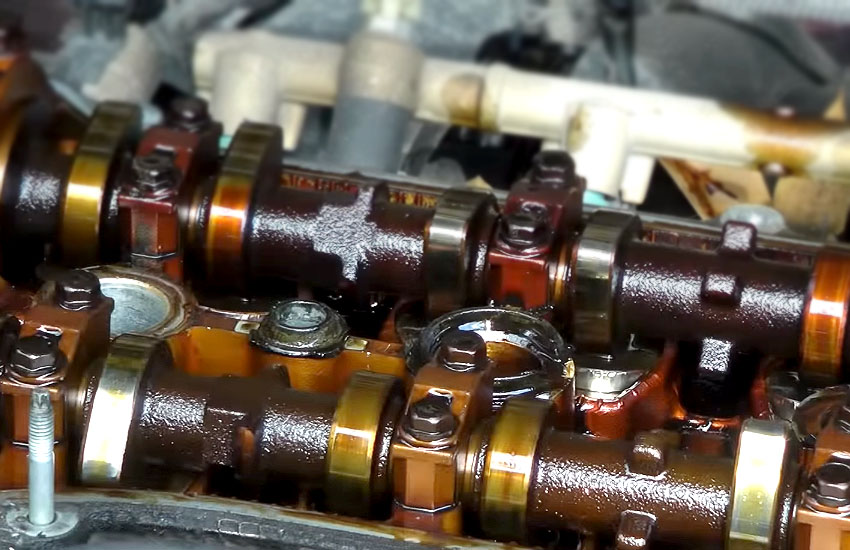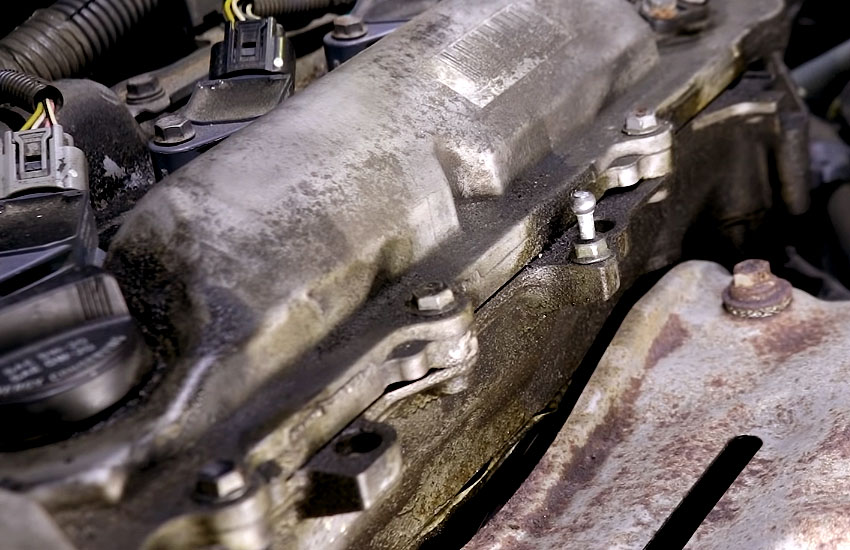An oil leak in a car can be a cause for concern, as it not only leads to a messy workspace, but it can also indicate underlying issues with the vehicle’s engine or other components. Addressing the problem promptly is essential to prevent further damage and costly repairs.
We will provide you with a simple and effective solution to stop an oil leak in your car. By following these steps, you can identify the source of the leak and take the necessary measures to repair or replace the damaged component, ensuring the longevity and smooth performance of your vehicle. So, let’s get started and put an end to that pesky oil leak.

Identifying An Oil Leak
Identifying an oil leak in your car can save you from potential engine damage and costly repairs. By proactively checking for oil leaks, you can address the issue before it worsens. There are a few key indicators that can help you determine whether your car has an oil leak. In this section, we will discuss two effective methods to identify an oil leak: checking for oil puddles and examining oil levels.
Checking For Oil Puddles
One of the easiest ways to identify an oil leak is by checking for oil puddles under your car. If you notice any dark, greasy stains on the ground where your car is parked, it could be a sign of an oil leak. You might also find these oil puddles in your garage or driveway. To properly inspect for oil puddles, follow these steps:
- Park your car on a clean, flat surface.
- Leave your car parked for at least 30 minutes.
- After sufficient time has passed, inspect the ground beneath your car.
If you spot any puddles that resemble oil, it’s crucial to address the leak promptly. Oil leaks can be caused by various factors, such as worn gaskets, seals, or even a loose drain plug.
Examining Oil Levels
Another method to identify an oil leak is by examining the oil levels in your car. Keep in mind that this method requires regular maintenance and check-ups. By monitoring the oil levels, you can spot any sudden drops, which may indicate a leak. To examine oil levels, follow these simple steps:
- Open the hood and locate the dipstick.
- Remove the dipstick and wipe it clean with a cloth or paper towel.
- Insert the dipstick back into the tube, fully seating it.
- Remove the dipstick again and observe the oil level on the marked portion.
If the oil level is consistently lower than the recommended range, it could be a sign of an oil leak. Additionally, if you notice any unusual odors or smoke coming from your engine, it’s crucial to investigate further for potential leaks.
Identifying an oil leak in your car is crucial for maintaining the overall health and performance of your vehicle. Regularly checking for oil puddles and examining oil levels can help you catch leaks early on, preventing further damage and potential breakdowns. In the next section, we will discuss effective methods to stop an oil leak in your car, allowing you to maintain a smooth and efficient driving experience.
Causes Of Oil Leaks
The causes of oil leaks in a car can vary, but they often occur due to certain components wearing down or becoming damaged over time. It’s crucial to identify these causes early on to prevent further damage to your car’s engine and avoid costly repairs. In this section, we will discuss three common causes of oil leaks and how to address them effectively.
Worn Gaskets And Seals
One of the most common causes of oil leaks in cars is worn gaskets and seals. Gaskets and seals are essential for preventing oil from leaking out of various engine components. Over time, these gaskets and seals can deteriorate due to heat, pressure, or natural wear and tear. When this happens, oil can seep through the gaps and cause leaks.
To address this issue, you will need to replace the worn gaskets and seals. It is crucial to identify the specific location of the leak, as gaskets and seals can be found in various parts of the engine, such as the valve cover, oil pan, or head gasket.
Once you have identified the faulty gasket or seal, you can purchase a suitable replacement and follow the manufacturer’s instructions for installation. Remember to properly clean and prepare the area before installing the new gasket or seal to ensure a tight and secure fit.
Damaged Oil Pan
Another common cause of oil leaks is a damaged oil pan. The oil pan is located at the bottom of the engine and holds the engine oil when the car is not in operation. Over time, the oil pan can get damaged due to road debris, speed bumps, or improper installation. A damaged oil pan can develop cracks or holes, leading to oil leaks.
If you suspect that a damaged oil pan is causing the oil leak in your car, you will need to inspect it carefully. Start by visually examining the oil pan for any visible cracks, dents, or holes. You can also check for oil residue around the pan, which indicates an active leak.
If you find any damage, you may need to replace the oil pan. Consult your car’s manual or a trusted mechanic for the correct replacement part and procedure. It’s essential to drain the oil completely before removing the damaged oil pan and installing the new one to ensure a proper seal.
Loose Or Broken Oil Filter
The oil filter plays a crucial role in removing impurities from your car’s engine oil. However, over time, the oil filter can become loose or even break, leading to potential oil leaks. If the oil filter is not tightly secured, oil can seep out from the filter housing, causing leaks.
If you suspect that a loose or broken oil filter is causing the oil leak, start by locating the oil filter. It is typically located near the engine block or the oil pan. Carefully inspect the filter for any visible signs of damage or looseness. If you find any issues, you will need to replace the oil filter with a new one.
Before removing the old filter, be sure to place a drain pan underneath to catch any spilled oil. It’s crucial to properly tighten the new oil filter to prevent future leaks. Check your car’s manual or consult a professional for the correct size and type of oil filter.
Fixing An Oil Leak
We will explore different methods for fixing an oil leak, including replacing gaskets and seals, repairing or replacing the oil pan, and replacing the oil filter. By following these steps, you can ensure that your car stays in great shape and avoid any further complications.

Replacing Gaskets And Seals
If you notice oil leaking from your engine, one of the most common culprits could be worn-out gaskets and seals. Over time, these components can deteriorate due to heat and exposure to engine oil, leading to leaks. Fortunately, replacing gaskets and seals is a relatively straightforward process that can be done at home. Here’s a step-by-step guide on how to replace them:
- Begin by identifying the leaking gasket or seal. This can usually be determined by locating the source of the oil leak.
- Once you have identified the problem area, use a wrench to carefully remove the bolts securing the gasket or seal in place.
- After removing the old gasket or seal, clean the mating surfaces thoroughly to ensure proper adhesion of the new component.
- Apply a small amount of oil-resistant sealant to the new gasket or seal to enhance its effectiveness.
- Carefully position the new gasket or seal in place, aligning the bolt holes properly.
- Tighten the bolts gradually, using a crisscross pattern to ensure even pressure distribution.
- Double-check the tightness of the bolts and wipe off any excess sealant or oil residue.
By following these steps, you can effectively replace worn-out gaskets and seals, eliminating oil leaks and preventing further damage to your engine.
Repairing Or Replacing The Oil Pan
The oil pan is another common component that can develop leaks over time. This critical part holds the engine oil and is prone to damage from road debris or corrosion. Repairing or replacing the oil pan can help you stop oil leaks and ensure the proper functioning of your car’s engine. Here’s how you can go about it:
- Safely raise your car using jack stands and locate the oil pan. It is generally situated at the bottom of the engine.
- Inspect the oil pan for any visible signs of cracks, holes, or damage. If the damage is minor, you may be able to repair it using an oil pan repair kit.
- If the damage is extensive or beyond repair, you may need to replace the oil pan entirely. To do this, carefully remove the bolts securing the oil pan to the engine block.
- After removing the old oil pan, clean the mating surfaces on the engine block.
- Position the new oil pan in place, ensuring that the gasket or seal is properly aligned.
- Tighten the bolts gradually and evenly to secure the new oil pan in place.
- Double-check the tightness of the bolts and refill the engine with the recommended amount of oil.
By repairing or replacing the oil pan, you can effectively address oil leaks and maintain the longevity of your car’s engine.
Replacing The Oil Filter
The oil filter plays a crucial role in keeping the engine oil clean, removing contaminants and debris that can impact its effectiveness. Over time, oil filters can become clogged or damaged, resulting in oil leaks. Here’s a step-by-step guide on how to replace the oil filter:
- Locate the oil filter, which is typically located near the engine block.
- Use an oil filter wrench to remove the old filter in a counterclockwise direction.
- Before installing the new oil filter, lubricate the rubber gasket with a thin layer of fresh oil.
- Hand-tighten the new oil filter until it touches the engine block, then use the oil filter wrench to tighten it an additional three-quarters of a turn.
- Wipe off any excess oil around the filter and check for leaks.
By replacing the oil filter regularly, you can prevent oil leaks and ensure the optimal performance of your car’s engine.
Final Words
Taking immediate action to address an oil leak in your car is crucial for maintaining its performance and longevity. By regularly inspecting your vehicle, identifying the source of the leak, and utilizing appropriate remedies like replacing a faulty gasket or seal, you can prevent further damage and ensure a smooth driving experience.
Remember, tackling oil leaks promptly not only saves you from costly repairs but also promotes a cleaner environment. Prioritize your car’s maintenance today to avoid any potential oil leak headaches in the future.

